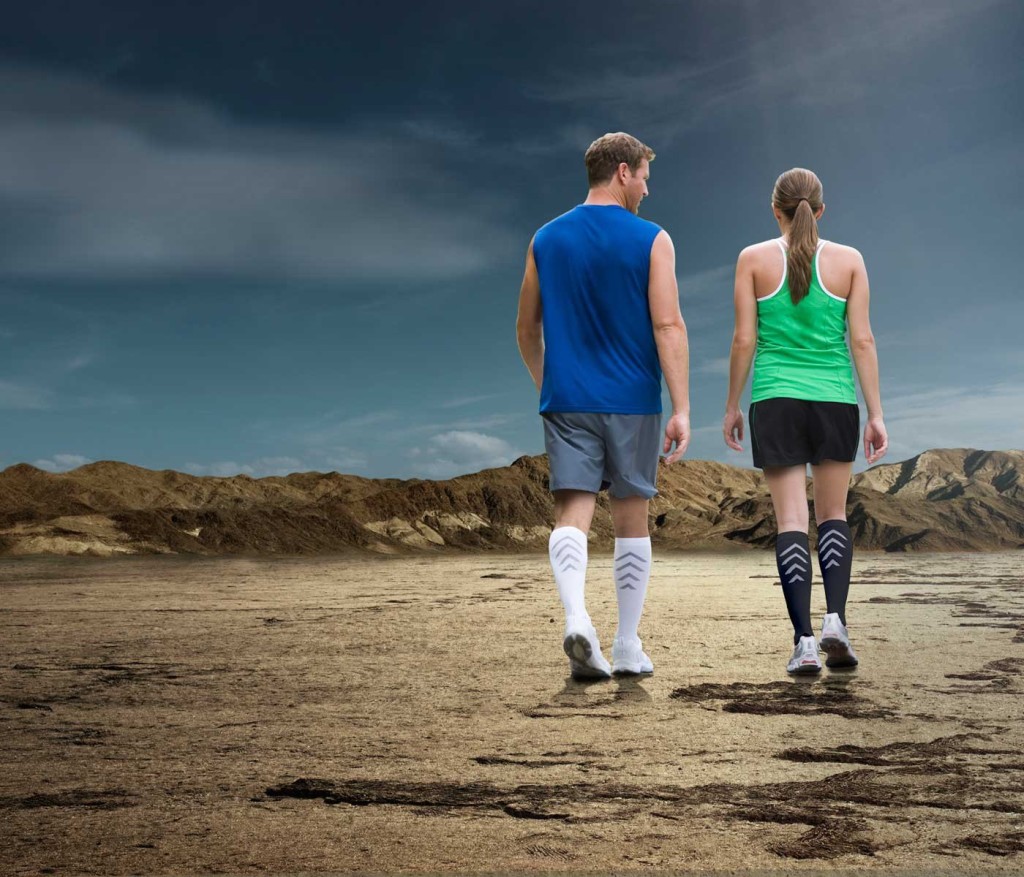 At the beginning of November, I was lucky enough to have the opportunity to run the 2014 NYC marathon. I had a blast racing the event, but as I write this article, my legs are yet to functionally bend at the knee thus rendering stair walking a hilariously debilitating act (hilarious for those around me anyway). Time to speed up the recovery process…but how? Today I am going to take a quick look at using compression socks.
At the beginning of November, I was lucky enough to have the opportunity to run the 2014 NYC marathon. I had a blast racing the event, but as I write this article, my legs are yet to functionally bend at the knee thus rendering stair walking a hilariously debilitating act (hilarious for those around me anyway). Time to speed up the recovery process…but how? Today I am going to take a quick look at using compression socks.
How compression works
Researchers now understand that compression socks help with recovery, to a small degree, when used after a hard effort. The mechanism of action is simple: it helps to prevent pooling of blood and facilitates better venous return (aka enhanced blood transportation from the legs back to the heart). The reason why this works is because veins (the blood vessels that feed blood back to the heart) do not have muscular walls like the arteries that bring blood away from the heart. So, while arteries actively help to pump blood away, veins rely on that momentum generated by the heart and arteries, and simply act as passive channels to bring the blood back.
So how does compression help? The more tension the vein is under, the more constricted and narrow that canal will become. Picture filling your mouth with water, and then trying to squirt it through your lips as far as you can. Do you open your mouth wide, or do you pucker your lips as tightly as you can? You pucker your lips! Compression socks help to achieve a similar effect, essentially puckering our veins to help squirt blood back to the heart.
Another common question is with regards to the benefit of using compression garments DURING a race. Some people swear by them. If you love your compression socks, I’m not going to tell you to stop. However, the research is much less promising for the benefits of using them while you run. The reason for this is that as we run our musculature (including our powerful calf muscles) engage to propel us forward. These muscles also have a secondary function working as a “blood pump.” As they contract, they squeeze the veins with a very powerful force. Because our veins have valves that only permit flow in one direction, as they are squeezed, blood rushes out of the legs and toward the heart. The thing is, this muscular contraction is so powerful that the small amount of compression supplied by a compression sock will have a negligible impact on your recovery. A calf muscle is stronger than a tight sock! That being said, other than maybe a small amount of excess heat retention, I do not think there is a detrimental effect to using compression socks while you run, so stick with them if you swear by them.
This brings me to the research I have been looking into recently. In theory we can see why compression socks work after a run, but just how much of an impact is there? Here is a great study from 2014 that tries to quantify the effect. In the study, 33 runners ran a marathon. Afterward, some wore compression socks for 48 hours, others did not. 2 weeks later, both groups were tested for their time to exhaustion- the longer a runner lasts, the better their recovery. This is what they found:
The time to exhaustion increased by 2.6% in the compression sock group, while it decreased by 3.4% in the placebo group.
So, while the compression group showed a slight improvement in their time to exhaustion compared to their pre-marathon test (2.6%), the group that didn’t wear compression socks were still worse off than before the marathon (3.4% decrease). This is a net difference in recovery of 6% (on average) simply by wearing compression socks for 48 hours!
Practical applications
I especially like this study because it is functional. It’s cool and important to look at physiological outcomes like inflammatory markers, but at the end of the day, as runners we want to do the stuff that makes us run faster, and that’s what these authors looked it. So, as a recovery strategy after your race, I think wearing compression socks for 48 hours is a good strategy to implement.
On that note, it is also important to keep in mind staying active will help you to a much greater degree. Definitely don’t run. But, going for walks, going for a swim, spinning on a bike- all of these activities will safely enhance circulation in the legs, activate that “blood pump,” and improve your recovery to a much greater degree than compression socks will.
I think the best way to view compression socks is as an added bonus when you have to sit down (i.e. if you are working at a desk the next day). Being active, if you have the option, will always trump the socks.
Dr. Sean Delanghe, BSc. (Hons), DC is a chiropractor, coach, and a regular contributor to the RunWaterloo blog.


